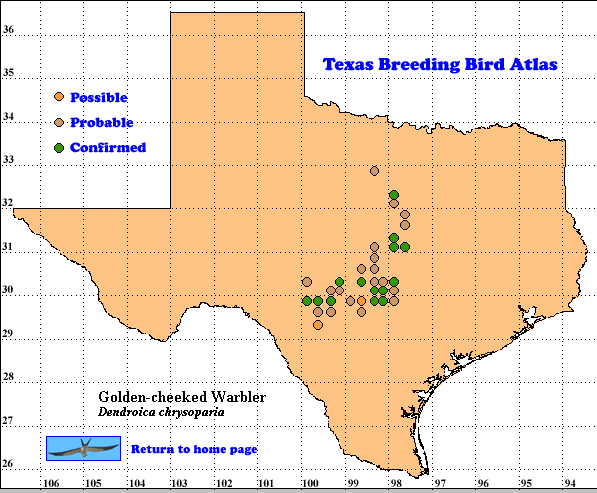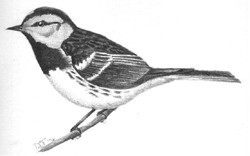Dendroica chrysoparia
The Golden-cheeked Warbler is the only bird species that breeds exclusively in Texas. This bird is very striking, with its bright yellow cheeks offset by a black throat and back, but it is most often found by its distinctive buzzy song rising out of the wooded canyons in which it breeds. The Golden-cheeked breeds in central Texas with a range that coincides closely with that of the Ashe Juniper (Juniperus ashei) (Pulich 1976), and winters in the highlands of Central America from southern Mexico to Nicaragua. On migration, this warbler generally uses the Sierra Madre Oriental of Mexico, but records exist for Florida, the Virgin Islands, and California.
DISTRIBUTION: In Texas, TBBAP data indicate that the Golden-cheeked Warbler breeds along the Balcones Escarpment, in the eastern and southern part of the Edwards Plateau, on the Lampasas Cut-Plain and the Llano Uplift. The following counties are part of the warbler’s historical range (Pulich 1976) but are not represented in the TBBAP data: Eastland, Edwards, Erath, Hamilton, Hood, Johnson, Kinney, Medina, Stephens, and Williamson. Supplemental data from the U. S. Fish and Wildlife Service show that the Golden-cheeked was found in Williamson County (latilong 30097, quad F7) during the Atlas period with a status of probable (C. Beardmore, pers. comm.). Of the rest of these counties, only Edwards and Medina contain much warbler habitat (Wahl et al. 1990).
SEASONAL OCCURRENCE: Breeding of the Golden-cheeked Warbler is difficult to confirm, with only 24% of 83 total records representing confirmed records. Nests are difficult to find, as shown by a lack of records of nests with eggs and with only three records of nests with young (15% of all confirmations). The Golden-cheeked is most easily found by vocalization. Some form of vocal activity was associated with 75% of all records. Most of the confirmed records were associated with begging young: 15% for young in the nest and 70% for fledged young.
The Golden-cheeked is an early breeder. They return from their wintering grounds by the middle of March with song activity peaking in April and declining thereafter until virtually ceasing by the end of June (Pulich 1976). In May and June, the sharp begging “chip” notes of the young become apparent. Fall migration begins in early July with most birds having left by August (Oberholser 1974). Reported egg dates for the Golden-cheeked are 1 April to 27 June (Bent 1953). TBBAP data do not document any earlier or later dates.
BREEDING HABITAT: Golden-cheeked Warblers breed in dense forests and woodlands dominated by mature Ashe Juniper, but also containing a mixture of other, mostly deciduous tree species. Locally, these woodlands are often gcwapen.gif (17829 bytes)
Art by Diane Taylor called “cedar brakes”. Warblers commonly place their nests in Ashe Junipers, but nests have also been found in a variety of oaks, elms, and walnuts, in addition to pecan and bald cypress (USFWS 1992). The small, cup-shaped nests are woven by the females from strips of Ashe Juniper bark secured by cobwebs (Pulich 1976). The nests are lined with fine grass, rootlets, feathers, hair, moss, lichens, and oak leaves. Golden-cheekeds are single-brooded, but will re-nest if the first attempt fails (Pulich 1976).
STATUS: The Golden-cheeked Warbler was listed as endangered under the Endangered Species Act by the U.S. Fish and Wildlife Service on May 4, 1990 by means of an emergency rule, with final listing on December 27, 1990. This action followed several decades of concern about the warbler’s future (Oberholser 1974, Pulich 1976, Wahl et al. 1990).
The most important threat facing the warbler is the loss of habitat from urbanization and from clearing for agricultural use (USFWS 1992). Secondary threats include loss of oaks from oak wilt (Ceratocystis fagacearum), nest parasitism by the Brown-headed Cowbird (Molothrus ater), and habitat fragmentation. Although the warbler occurs on public lands throughout its range, long-term protection may not be possible without assistance from private landowners (Sexton 1992).
A determination of the overall status of an endangered species from the TBBAP data must be made with caution. A smaller range than expected may represent incomplete coverage or it may represent extirpation in those areas or a combination of both. With the Golden-cheeked Warbler, incomplete coverage cannot be ruled out. Most of the land within the warbler’s range is privately owned and access in some areas may have been restricted. Only small amounts of suitable habitat occur in most of the counties not represented by TBBAP data, which tends to magnify the problems of access due to private ownership. Additionally, this bird is difficult to find along roads. Breeding Bird Survey data show only two records on one route between 1965 and 1979 (Robbins et al. 1986). Thus, the range restriction indicated by the TBBAP data may have been the result of incomplete coverage and not extirpation in those areas. Legal surveys on private lands are needed to determine if the Golden-cheeked Warbler is no longer breeding in those areas. Text by Cade L. Coldren (ca. 1993)
 Literature cited
Literature cited
Bent, A.C. 1953. Life histories of North American wood warblers. U.S. Nat. Mus. Bull. No. 203.
Oberholser, H. C. 1974. The bird life of Texas. University of Texas Press, Austin.
Pulich, W .M. 1976. The Golden-cheeked Warbler: A bioecological study. Texas Parks and Wildlife Department, Austin, Texas.
Robbins, C. S., D. Bystrak, and P. H. Geissler. 1986. The breeding bird survey: Its first fifteen years, 1965-1979. U.S. Fish and Wildl. Serv., Resource Publ. No. 157.
Sexton, C. 1992. Rare, local, little-known, and declining North American breeders: The Golden-cheeked Warbler. Birding 24:373-376.
U.S. Fish and Wildlife Service. 1992. Golden-cheeked Warbler (Dendroica chrysoparia) recovery plan. Albuquerque, New Mexico.
Wahl, R., D. D. Diamond, and D. Shaw. 1990. The Golden-cheeked Warbler: a status review. Unpublished report submitted to Ecological Services, U.S. Fish and Wildlife Service.
